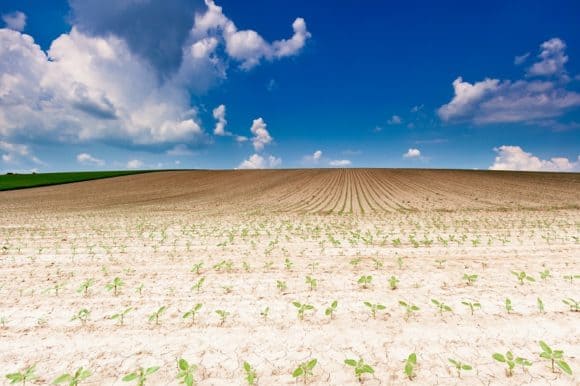By Marlene Palka, research assistant in the IIASA Risk and Resilience Program
Marlene Palka discusses the work done by the IIASA FARM project, which has been investigating drought risk management in Austria for the past three years.
Future climate projections forecast an increase in both the frequency and severity of droughts, with the agricultural sector in particular being vulnerable to such extreme weather events. In contrast to most other climatic extremes, droughts can hit larger regions and often for extended periods – up to several months or even years. Like many other countries, Austria has been and is expected to be increasingly affected, making it necessary to devise a management strategy to mitigate drought damages and tackle related problems. The FARM project – a three year project financed by the Austrian Climate Research Program and run by the IIASA Risk and Resilience and Ecosystems Services and Management programs – kicked off in 2017 and has been investigating agricultural drought risk management both in a broad European context, and more specifically in Austria.

Young sunflowers on dry field © Werner Münzker | Dreamstime.com
Austria represents a good case study for agricultural drought risk management. Despite the agricultural sector’s rather small contribution to the country’s economic performance, it still has value and represents an important part of the country’s historical and cultural tradition. Around 80% of Austria’s total land area is used for agricultural and forestry activities. Equally important is its contribution to the preservation of landscapes, which is invaluable for many other sectors including tourism.
Globally, agricultural insurance is a widely used risk management instrument that is often heavily subsidized. Apart from the fact that the concept is increasingly being supported by European policymakers – the intention being that insurance should play a more prominent role in managing agricultural production risk – more and more voices from other sectors are calling for holistic management approaches in agriculture with the overall aim of increasing the resilience of the system.
There is a well-established mutual agricultural insurance company in Austria, which has high insurance penetration rates of up to 75% for arable land, and comparably high subsidies of up to 55% of insurance premiums. It is also encouraging to note that recent policy decisions support the timeliness of drought risk: in 2013, the Austrian government paid EUR 36 million in drought compensation to grassland farmers and in 2016, premium subsidies of 50% were expanded to other insurance products, including drought, while ad-hoc compensation due to drought was officially eliminated. In 2018, the subsidy rate was further increased to 55%. In light of these prospects, we investigated the management option space of the Austrian agricultural sector as part of the FARM project.
The 2018 Organisation for Economic Co-operation and Development (OECD) report on monitoring and evaluation of agricultural policies claims that efficient (drought) risk management in agriculture must consider the interactions and trade-offs between different on-farm measures, activities of the private sector, and government policies. The report further argues that holistic approaches on all management levels will be vital to the success of any agricultural management strategy.
In the course of our work, we found that agricultural drought risk management in Austria lacks decision making across levels. Although there is a range of drought management measures available at different levels, cooperation that includes farms, public and private businesses, and policy institutions is often missing. In addition, measures to primarily and exclusively deal with drought, such as insurance and irrigation, are not only limited, but (as we found) are also less frequently implemented.
As far as insurance is concerned, products are still being developed, and penetration rates are currently low. Drought risk is also highly uncertain, making it almost impossible to offer extensive drought insurance products. Irrigation is perceived as the most obvious drought management measure among non-agronomists. Simply increasing irrigation to deal with the consequences of drought could however lead to increased water demand at times when water is already in short supply, while also incurring tremendous financial and labor costs and additional stress to farmers. With that said, a large number of agricultural practices may also holistically prevent, cope with, or mitigate droughts. For example, reduced soil management practices are low in operating costs and prevent surface run-off, while simultaneously maintaining a soil structure that facilitates increased water holding capacity. Market futures might also stabilize farm income and therefore allow for future planning such as the purchase of irrigation equipment.
A workshop we held with experts from the Austrian agricultural sector further highlighted this gap. Thinking (not even yet acting) beyond the personal field of action was rare. The results of a survey we conducted showed that farmers were experiencing feelings of helplessness regarding their ability to manage the negative effects of droughts and other climatic extremes despite the implementation of a broad range of management solutions. One way to explain this could be a lack of cooperation across different management levels, meaning that existing efforts – although elaborate and well-proven – potentially reach their limit of effectiveness sooner rather than later.
Due to the more complex effects of any indirect/holistic drought management measure, we need tailored policies that take potential interdependencies and trade-offs into account. With evidence from the FARM project, my colleagues and I would like to emphasize an integrated risk management approach, not only at farm level but also in all relevant agencies of the agricultural sector in an economy. This will help to secure future production and minimize the need for additional public financial resources. Our findings not only contribute to ongoing high-level discussions, but also underpin the resulting claim for more holistic (drought) risk management with bottom-up data from our stakeholder work.
Note: This article gives the views of the author, and not the position of the Nexus blog, nor of the International Institute for Applied Systems Analysis.

You must be logged in to post a comment.